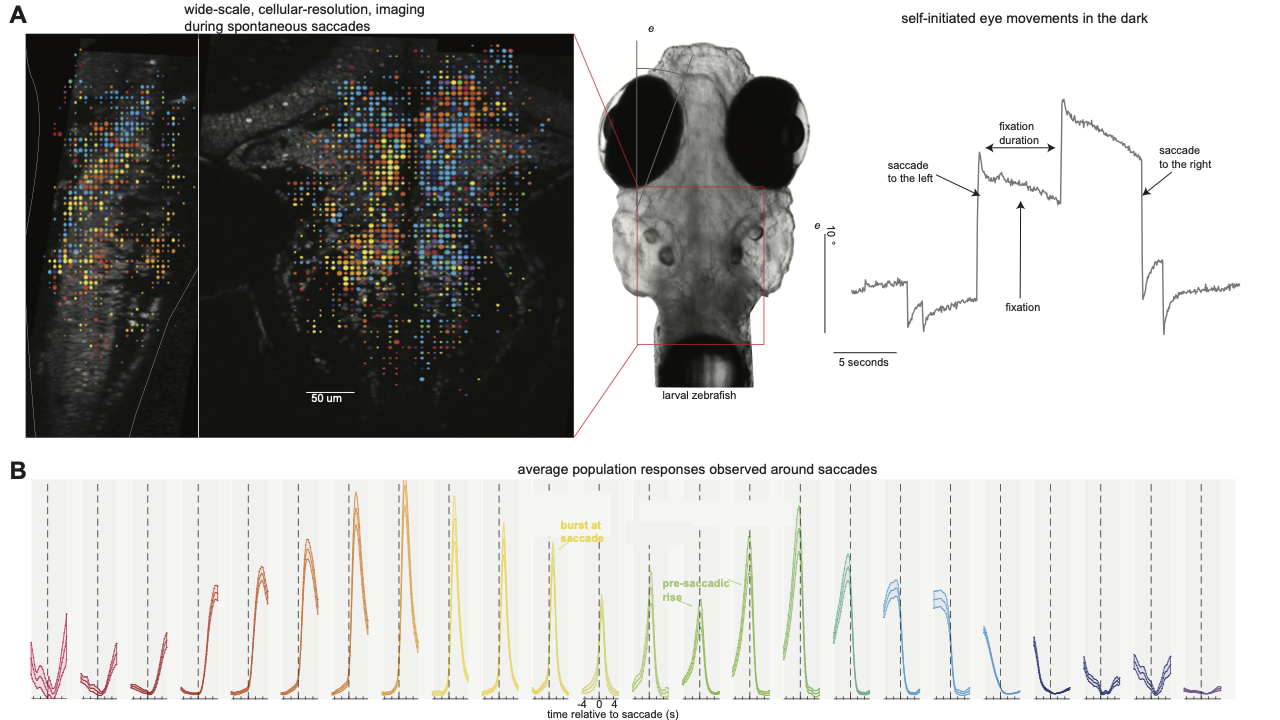
Alexandro Diaz Ramirez, PhD
Assistant Professor
Department of Physiology and Pharmacology
Whole-circuit, cellular-resolution, dissection of decision-making mechanisms
My lab is focused on understanding how neural circuits make decisions. Animals make decisions based on external sensory signals and internal neural activity. A detailed understanding of how the nervous system makes decisions by combining external and internal information is lacking. Our research aims to uncover cellular and circuit mechanisms that explain how brains integrate internally-generated activity with sensory signals to form decisions. To do this, we focus on oculomotor circuits in the larval zebrafish because of the power this system provides for quantitatively characterizing decision-making.
Oculomotor circuits provide a rich system for studying decision-making because animals continuously decide when, and in which direction, they should move their eyes. Rapid eye movements, known as saccades, are an ideal behavior for understanding how neural circuits combine internal neural activity with sensory-evoked activity to make decisions. Saccades are an instinctual behavior that can be evoked without external stimuli and that can be modified by learning. To understand the role internally-generated signals serve in decision-making, we observe neural activity across the brain as the animals makes saccades with and without visual stimuli (Figure 1).

Figure 1. An animal model for studying brain-wide circuit mechanisms that produce self-initiated decisions. A) Map of larval zebrafish hindbrain locations containing cells that respond during spontaneous eye-movements made in the dark. Colors denote typical neural response at that location using the legend shown in B. B) Deconvolved, neuronal calcium responses around the time of saccade from cells distributed across the hindbrain.
Our research has uncovered that when animals decide to saccade without visual stimuli, they rely on a neural activity pattern that is like what is seen during decision-making tasks that rely on external stimuli; single-cell neural activity gradually rises to a consistent level before each saccade. We have shown a causal role for this neural activity pattern in decision-making; ablation of individual cells that display this activity pattern disrupts the distribution of times when animals decide to move their eyes. The lab is focused on understanding the origin of this rise in activity, how it is used to make decisions, and the mechanisms by which the rise can be sustained. To do this, we study oculomotor circuits in the larval zebrafish, a model organism that offers several advantages for understanding the logic of neural circuits at the level of individual cells. At the ages we study, the larval zebrafish contains around 100,000 neurons and is transparent which allows one to use cellular resolution, optical imaging tools to observe neural activity from entire circuits distributed across its brain. Ultimately, we would like to understand why neural ramping before a decision is seen across so many species and tasks.
- Sylvester, S. J. G., Lee, M. M., Ramirez, A. D., Lim, S., Goldman, M. S., and Aksay, E. R. F. (2017). Population-scale organization of cerebellar granule neuron signaling during a visuomotor behavior. Sci. Rep. 7.
- Vishwanathan, A., Daie, K., Ramirez, A. D., Lichtman, J. W., Aksay, E .R. F., and Seung, H. S. (2017). Electron microscopic reconstruction of functionally identified cells in a neural integrator. Current Biol. 27, 2137-2147.
- Ma, M., Ramirez, A .D., Wang, T., Roberts, R. L., Harmon, K. E., Schoppik, D., Sharma, A., Kuang, C., Goei, S. L., Gagnon, J. A., Zimmerman, S., Tsai, S. Q., Reyon, D., Joung, J. K., Aksay, E. R. F., Schier, A. F., and Pan, Y. A. (2020). Zebrafish dscaml1 deficiency impairs retinal patterning and oculomotor function. J. Neurosci. 40, 143-158.
- Ramirez, A.D., and Aksay, E.R.F. (2021). Ramp-to-threshold dynamics in a hindbrain population controls the timing of spontaneous saccades. Nature Commun. 12, 4145-4145.